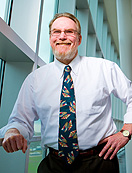News
UDP plan for Buffalo wins major award
-
 Print
Print -
 Comments
Comments
-

Robert Shibley heads up the Urban Design Project, which produced an ensemble of planning documents for the City of Buffalo that won the 2009 Charter Award from the Congress for the New Urbanism.
The City of Buffalo has received the 2009 Charter Award from the Congress for the New Urbanism (CNU), one of the foremost international advocates for the revival of cities, for an ensemble of plans produced by UB’s Urban Design Project (UDP).
UDP, part of the School of Architecture and Planning, is led by Robert Shibley, professor of architecture and urban planning and director of the UDP. The Charter Award was presented last week to Buffalo Mayor Bryon W. Brown during the CNU’s annual conference in Denver.
The award is one of only two charter awards made this year by the CNU for projects at the scale of region, city and town. The Buffalo entry won in competition with 125 plans submitted by some of the best planners and urban designers in the world.
It comprises four documents:
• “The Queen City in the 21st Century: Buffalo’s Comprehensive Plan.”
•“The Queen City Hub, Vols. I and II: A Regional Action Plan for Downtown Buffalo.”
•“Queen City Waterfront—Buffalo Waterfront Corridor Initiative: A Strategic Plan for Transportation Improvements.”
•“The Olmsted City—The Buffalo Olmsted Park System: Plan for the 21st Century,” which also received the 2009 Excellence in Historic Preservation Award from the Preservation League of New York State.
The ensemble of plans is the result of a long-running collaboration that has involved the City of Buffalo (including two mayoral administrations and many planning directors), Buffalo Place Inc., Buffalo’s Olmsted Parks Conservancy, the Greater Buffalo-Niagara Regional Transportation Council, and many others.
In applying for the award, the city noted that a decade ago, “Buffalo lacked any meaningful planning framework for stimulating the regeneration of the city or for organizing its progress. Today, we have a plan for the whole and plans that address three crucial elements of our urban legacy: downtown, the waterfront and our parks.”
“Buffalo’s plans have gone head-to-head with the best in the world and won again,” Shibley says. “This award is a great honor for the city and a fantastic endorsement of the framework for the future that the city has laid out. It means the leaders of an international movement for urban revival have recognized our work as a model for the world.”
The UDP, a small research center founded 20 years ago, continues to work for the recognition and implementation of Buffalo’s comprehensive planning framework with city, community and business leadership.
“Past city development has been scattershot, a matter of ‘throwing paint on a canvas,’ whereas the new plans identify a critical mass of supporters, map critical resources, take into consideration the city’s declining population, identify locations for strategic action and ‘corridors of investment,’ find ways to leverage those investments and identify the tools necessary to manage the work,” Shibley notes.
The plan received crucial support from the John R. Oshei Foundation, the Margaret L. Wendt Foundation, the Baird Foundation, the Community Foundation of Greater Buffalo and many other partners—public and private.
In 2008, aspects of the comprehensive city plan won awards from the International Economic Development Council (for “Queen City Hub”), two Planning Excellence for a Best Practice Awards from the New York Upstate Chapter of the American Planning Association (for “Queen City Waterfront”) and The Planning and Analysis Honor of Excellence Award from the New York Upstate Chapter of the American Society of Landscape Architecture (for “The Olmsted City”).
The planning process for the Queen City plans began in the mid-1990s with a summit that brought the downtown community together in the studios of WNED-TV to discuss the best approach to take.
Between 1994 and 1996, 22 such “summits” and other events involving more than 6,000 city residents focused on building a consensus about the city’s future and organizing to take action on it.
In 1999, under the administration of Mayor Anthony Masiello, Buffalo Place and the UDP began work to implement key projects derived from citizen priorities for downtown Buffalo. The result was 12 completed projects and new planning ideas leading to ‘The Queen City Hub,’ which won the national American Planning Association award for Best Plan in 2005.
Subsequent planning and implementation work has focused on creating Buffalo’s official comprehensive plan—“Queen City in the 21st Century”—which was adopted by the Common Council in 2007, as well as plans for the Olmsted parks and the waterfront.
“During the past 15 years, through the Masiello and now in the Brown administrations,” Shibley says, “we have taken ourselves and the community to school on planning for the city. Now we not only have great plans, but a very sophisticated community constituency for them—people who know what they want and are setting an increasingly high standard for urban planning in this region.”
He says the new planning was necessary because although Buffalo is a city with great “bones,” wonderful waterways and Joseph Ellicott’s beautiful 1804 radial street plan (in 1869, Frederick Law Olmsted called it “the best planned city in America”), the new century presents some very different challenges to quality urban life.
“As the mayor has indicated,” Shibley says, “it is time to be even more aggressive about implementing this comprehensive planning framework, fashioning the tools it calls for and revising them as needed to be sure they meet the needs of the city and its people well into this century.”
Brown says he has initiated the reform of the city’s 50-year-old zoning code and created a new city planner position to help implement “Queen City in the 21st Century.”

Reader Comments